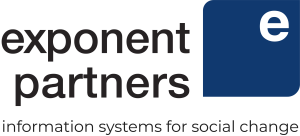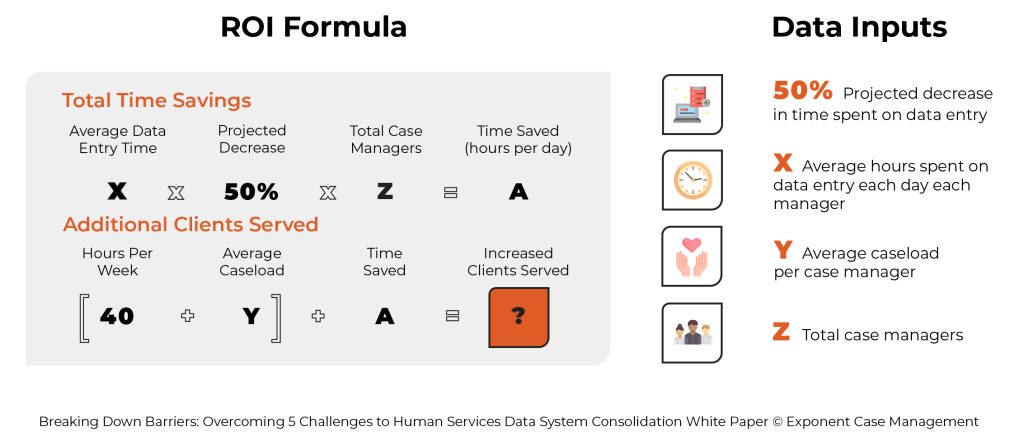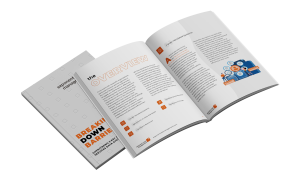5 Reasons Why Nonprofits Need to Embrace System Consolidation
It’s time to run your systems like your clients’ lives depend on them because they do.
Did you know that 30% of nonprofits fail to exist after 10 years according to the National Center on Charitable Statistics? A lack of innovation in leadership, organizational structure, and technology are some of the key reasons why. So how can you beat the odds when you are being asked to do more, often with less? From our experience helping nonprofits solve their most complex problems, we know the path forward is implementing one consolidated system where all your key processes are considered and executed consistently across the entire organization.
Does this sound like a challenge you are facing?
It’s hard to manage or attract staff with the current systems in place.
I have difficulty tracking program participation and measuring outcomes when clients are involved in multiple program offerings.
Overseeing data collection practices are a pain when everyone is working in different systems and don’t even get me started on reporting upwards.
If that resonates and you’re thinking there has to be a better way, there is. Ultimately, your systems set the entire organization up for success, save time and have a direct impact on the people you serve.
“When someone comes to SparkPoint, oftentimes they are coming because they have no other recourse. They are coming because they are hungry, because they have no place to live.” Chad Thompson, SparkPoint Program Director at Skyline College.
United Way Bay Area uses Exponent Case Management (ECM) to help track students in the SparkPoint program. “We want to make sure we are reporting accurately the work that is actually happening on the ground,” stated Nicole Harden, Director, Regional Learning and Partnerships at United Way Bay Area. “We want to be able to tell their stories. The tool we had before wasn’t able to do that for us. We had multiple databases that we were using, and anyone can tell you that that is super difficult!”
We live by the notion that one well-considered and implemented information system is a game-changer for nonprofits and human services agencies. Here are 5 reasons why:
If you can’t measure it, you can’t manage it.
Reporting on performance, outcomes, and compliance effectively is nearly impossible when you have scattered spreadsheets and data silos. With a 360 degree view of your program’s performance that considers all your various data sources, case managers and agency leaders alike can deliver data-driven strategies that produce the most meaningful results in the lives of clients.
One size does not fit all.
At the end of the day, we are all human and have different needs, as do our communities. Knowing how clients and the community at large engage with your programs can help you tailor multiple services and interventions at the right time.
Time is money.
If you’re having your case managers enter data into multiple systems, you are wasting time and money. Take a look at this helpful formula for calculating total time savings and increased social impact when duplicate data entry is diminished. Find out more in our recently published white paper, “Breaking Down Barriers: Overcoming 5 Challenges to Human Services Data System Consolidation.”
When you stop growing, you start dying.
The COVID-19 pandemic, has created a paradigm shift in how human services organizations operate. The way you engage with your clients has changed and the way services are delivered is constantly being reassessed. Secure and reliable systems that are built with innovation in mind can help you maintain continuity of operations when rapid changes need to be made.
Teamwork makes the dream work.
From internal teams to external stakeholders, collaboration enables a holistic approach to improving outcomes for those served. A case manager or program manager does not work in isolation. In fact, it’s quite the opposite, creating meaningful impact takes a symbiotic symphony of practitioners alike.
The fact of the matter is that human services data system consolidation makes it easier to drive better impact and radical social good innovation.
Change can be hard, especially when there are barriers in place that feel unsurmountable. So let us help you.
We examined how we have helped other clients overcome the common challenges that human services organizations face when consolidating their systems and picked the minds of some of our brightest to publish our latest resource-packed white paper, “Breaking Down Barriers: Overcoming 5 Challenges to Human Services Data System Consolidation.”
- Examples of how organizations are surmounting mandated systems
- Strategies for ensuring your internal teams are aligned
- Top tips for financial resources and staffing challenges



